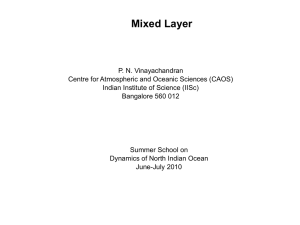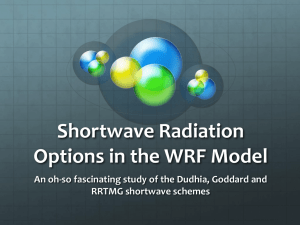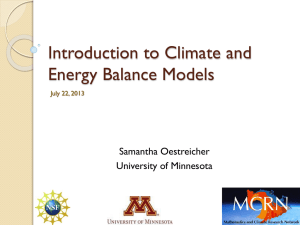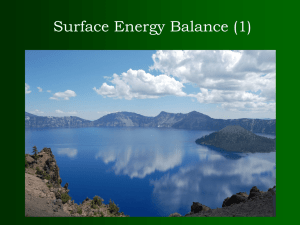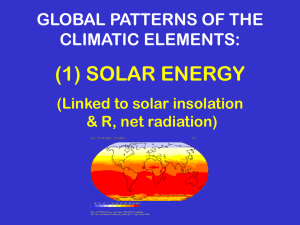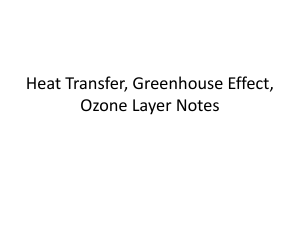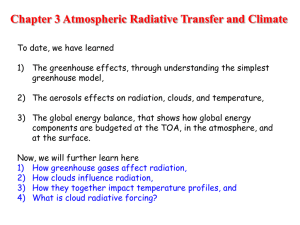Ecosystem energy balance
advertisement
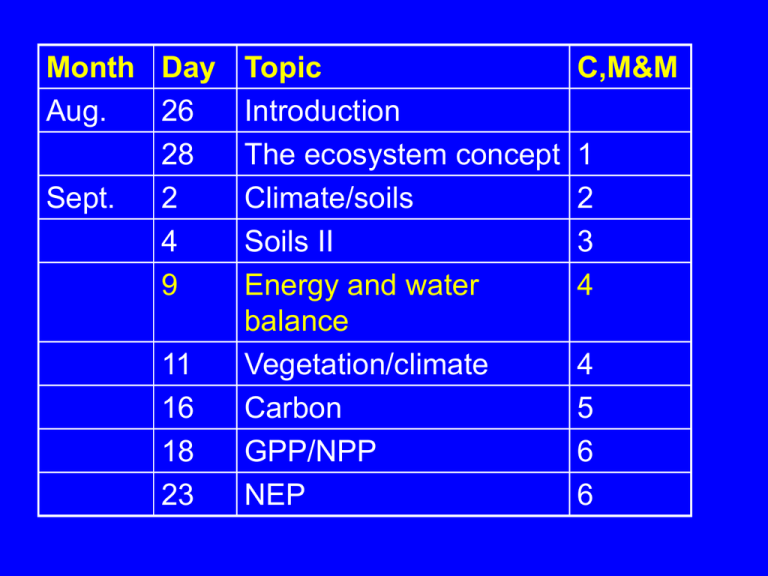
Month Day Topic Aug. 26 Introduction 28 The ecosystem concept Sept. 2 Climate/soils 4 Soils II 9 Energy and water balance 11 Vegetation/climate 16 Carbon 18 GPP/NPP 23 NEP C,M&M 1 2 3 4 4 5 6 6 Spatial scale of climate processes Macroclimate Global Mesoclimate Regional Microclimate Local Nanoclimate Organismal Picture of sun Radiation • Shortwave (K): UV and visible • Longwave (L): Infra-red, heat Energy in = Energy out 343 Watts/m2 Incoming radiation is mostly short wave (vis, NIR, UV) 31% reflected by clouds or surface Energy in = Energy out 343 Watts/m2 Incoming radiation is mostly short wave (vis, NIR, UV) 31% reflected by clouds or surface 20% absorbed by clouds and atmosphere 49% absorbed by earth surface Radiation absorption = increased T Longwave re-radiation Energy emitted = T4 = emissivity (0-1; black body-perfect radiator-equals 1) = Stefan-Boltzman constant (5.67x10-8 watts m-2 k-4) T = Absolute temp of emitting object (K) The “greenhouse” effect Energy Losses from the earth’s surface 23% lost as latent heat flux water vapor 7% lost as sensible heat flux conduction, convection Remainder lost as outgoing longwave At the ecosystem “surface”… Net radiation • Energy input to ecosystem (absorption) • Balance between – Input (long- and short-wave radiation) – Output (long- and short-wave radiation) Sunshine Reflectance Clouds, gas Earth’s surface Rnet = (Kin – Kout) + (Lin – Lout) How warm is the sky relative to the land? = (1 – albedo)Kin + (sky Tsky4- sur Tsur4) http://geography.uoregon.edu/envchange/clim_animations/#Global%20Energy%20Balance Ecosystem characteristics that affect Rnet • Albedo • Surface temperature (diff. between sky and surface T) – Factors that modify surface T • Roughness: canopy structure cause mixing and cooling • Water Net radiometer kin kout Radiation budget of a douglas fir forest Season Disturbance Canopy roughness Energy partitioning Rnet = H + LE + G + S Rnet = net radiation H = sensible heat flux LE = evapotranspiration G = ground heat flux S = change in storage S • Converted to chemical energy via Ps • Change in temperature of vegetation and soil • < 10% of Rnet in most ecosystems • Often ignored in studies of microclimate G = Ground • Conductive heat loss from surface • Depends on: – Thermal conductivity of substance – Thermal gradient • Negligible in tropical and temperate systems, big at high latitudes and altitudes LE = latent heat • Convective heat loss from surface • Evapotranspiration • Depends on vapor pressure gradient between ecosystem and atmosphere • Transfers water from ecosystem to atmosphere H = sensible heat • Conductive and convective heat loss from the surface • Depends on: – T difference between surface and overlying air – Turbulence • Convective turbulence = eddies Energy available for turbulent exchange (momentum) • Available energy = Rnet – (G + S) = H + LE • Bowen ratio: H/LE – inversely related to proportion of Rnet that drives water loss – Driven by water availability Characterizing functional differences among ecosystems… • Albdeo • Bowen ratio Lecture ended here


